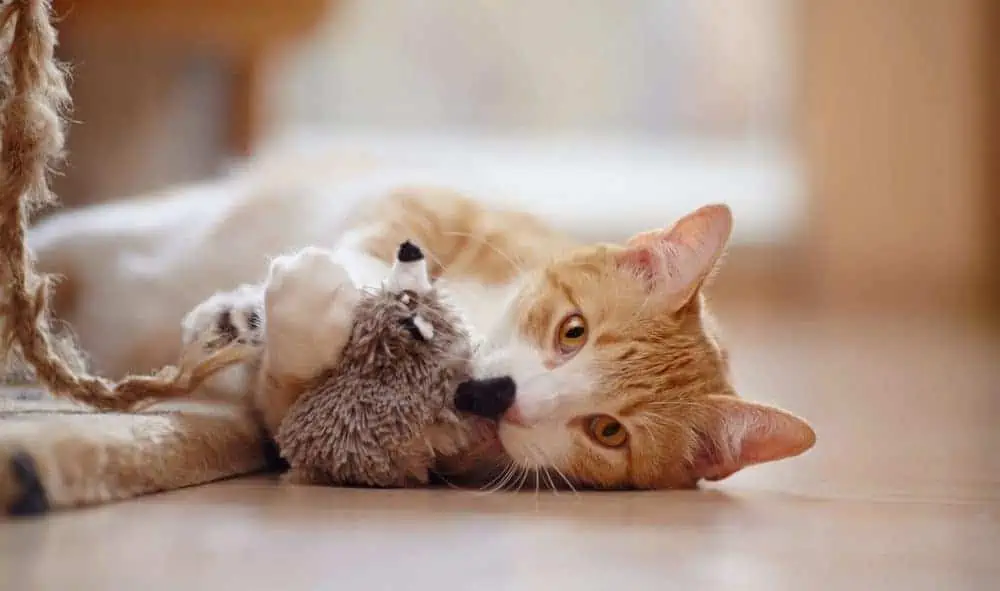
Like all baby animals, kittens love to play. As well as being lots of fun, play teaches young cats about the world around them, aids their physical development and hones their fabulous feline skills. As cats get older, play is a great way to keep fit, lean and healthy, as well as keeping their brain alert and active – something that remains important for the whole of their life.
For cats, the best games are those that make the most of their natural repertoire of behaviours – stalking, pouncing, chasing and batting objects with a paw, exploring, climbing, jumping and patrolling. These ‘hunting’ skills, replicated by pursuing or swiping at a toy, release feel-good hormones called endorphins, which boost feline feelings of wellbeing.
PLAYTIME TIP: Teach your kitten good manners and discourage them from scratching, clawing or biting. This may be fine when they’re little, but as those ‘weapons’ become larger, it can cause damage and pain. Source: International Cat Care
There are benefits for owners too. Playing with your cat regularly will teach you about your cat’s personality and strengthen the bond and trust between you. This is particularly important for those cats who are less cuddly, who are uncomfortable with being held or stroked. Playing with your cat is another way to show them that you love them.
How do I know if my cat wants to play?
According to International Cat Care, as cats are creatures that thrive on routine, they will have regular patterns of activity that they are unlikely to deviate from. For example, if mid-afternoon is nap-time, they won’t be up for a game. However, if your cat has a mad-half-hour, dashing round the house at nine o’clock at night, then you can safely surmise that this is a good time for a game. Clues that your cat’s in the mood to play include:
- Spontaneous play with objects
- Sudden staccato movements
- Dilated pupils, ears flattened, frozen postures, crouched legs
- ‘Mad half hour’
- Vocalisation
What toys will my cat like to play with?
Blue Cross advises that as cats are attracted to movement, choose toys that you can move around in rapid and unpredictable ways, just like a mouse or bird. Toys that reflect light are particularly attractive. Cats also like toys with different textures that are around the size of their natural prey. Many felines love squeaky toys, but some are startled by them, so introduce them carefully. Always tidy toys away after playtime for safety and check regularly for signs of wear and tear.
PLAYTIME TIP: Cats are naturally neophilic (excited by novelty) so rotate toys randomly to keep things exciting. Source: International Cat Care
As sensual animals for whom scent plays a big part in understanding the world, adding some toys filled with dried catnip (Nepeta cataria), will heighten their pleasure. About 50% of felines will respond to the active but harmless chemical in this herb, by going into raptures of rolling around and meowing. Scented toys can be particularly beneficial for blind cats.
Cats love to climb and hide, so getting a cat activity centre could be a good investment – although some cats will have endless fun playing in a selection of cardboard boxes.
How long should playtime last?
Every cat is an individual, but age is a factor here. Cats Protection advises that older cats may enjoy playing three or four times a day, while younger cats will be happy to play 10 times a day or more. Playtime doesn’t have to be prolonged and has the most beneficial effects if it’s provided relatively frequently in short energetic bursts of activity.
PLAYTIME TIP: Even older cats will enjoy the stimulation and gentle exercise of a game that is adapted to suit their level of mobility. Even if your cat lies down to play, it will still be beneficial, both physically and mentally. Source: International Cat Care
Remember the rules of the game
International Cat Care has compiled this handy list of cat etiquette:
- Let your cat dictate the pace of the relationship and always wait for your cat to make the first move.
- Don’t disturb your cat when it is asleep or resting.
- Ignore your cat if it is perched on a high place, like a shelf or cupboard. This respects its desire at that time to watch without being seen.
- A private spot for rest isn’t private if you disturb your cat while there, so respect these places of sanctuary.
- Less is more in the cat world – don’t overdo the petting.
- Don’t automatically stare at your cat when it comes into the room – most cats like to feel they can move around without always being the centre of attention.
For more expert advice on playing with your cat visit International Cat Care
If you found this interesting, you might like:
Cat chat While cats use a range of vocalisations such as yowling, hissing and growling to communicate with each other, meowing isn’t one of them. This is a behaviour they’ve adopted just for humans. But what are they trying to tell us?
Feline behaviour – strange, but true... Why does my cat rub around my legs, grab my hand when I tickle his tummy, drink from the tap and knock everything off my desk? Our mission is to solve some of the most puzzling feline mysteries...
Read my body language You and your cat might speak different languages, but look closer and you’ll see that your favourite feline is using their whole body to tell you how they’re feeling...
Sources: icatcare.org, cats.org.uk, bluecross.org.uk














